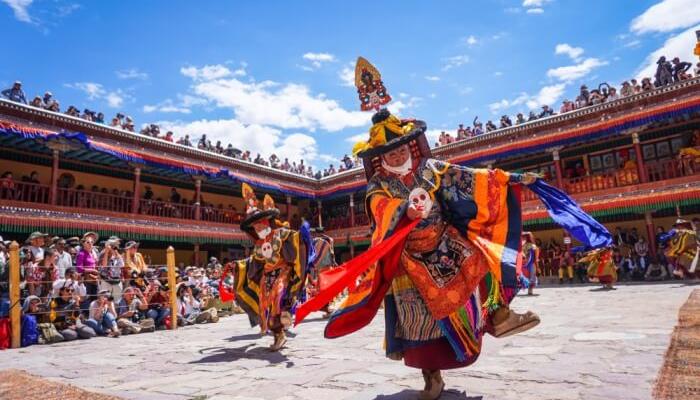Ladakh is predominantly a tribal region in the country.
It is estimated that more than 90% of Ladakh’s population is tribal.
The Scheduled Tribe population represent 66.8 percent in Leh, 73.35 percent in Nubra, 97.05 percent in Khalsti, 83.49 per cent in Kargil, 89.96 per cent in Sanku and 99.16 per cent in Zanskar areas of the Ladakh region.The official figures, however, does not include a number of communities including SunniMuslims in the region, who are claiming for Scheduled Tribe status. Taking into account this, the total tribal population in Ladakh region is more than 97 percent. The region is inhabited by following Scheduled Tribes, namely :
Thereby several distinct cultural heritages of these communities in Ladakh region needs to be preserved and promoted.
The passes of Ladakh connect Central Asia, South Asia and China, and the region is cut off from the rest of India for six months during winter.
The tribes here have limited means of livelihood, poor roads, impossible telecom and internet connectivity, undeveloped markets for their produce and low employment opportunities.
The proximity of the India-Pakistan-China border, and the ubiquitous presence of Indian Army and paramilitary forces, underlines not only Ladakh’s strategic sensitivity, but also its people’s vulnerability.
Tribes constitute 90% of the population of Ladakh — made up of the districts of Leh and Kargil. Gujjars, Bakarwals, Bots, Changpas, Baltis and Purigpas have played an important role in various wars that have been fought, and have been displaced and disturbed by border tensions.

Ladakh’s terrain is essentially inhospitable to agriculture and has been badly neglected by government agencies. In the apricot cluster of Kargil — which accounts for about half of J&K’s total apricot plantation —the crop has been annually afflicted by the codling moth for a decade. No solution for this blight has been sought yet.
Kargil’s famous apples were quarantined by Kashmiri lobbies from going beyond Kargil, and the produce was forced to be locally consumed. If some of the nomadic tribes in Ladakh are trained and funded to grow their livestock on a commercial scale, it could prevent a net outflow of as much as Rs 800 crore from going out of the region to other states.
The Changpa of Ladakh is high altitude pastoralists, raising mainly yaks and goats.
Among the Ladakh Changpa, those who are still nomadic are known as Phalpa, and they take their herds from in the Hanley Valley to the village of Lato.
Hanley is home to six isolated settlements, where the sedentary Changpa, the Fangpa reside.
Despite their different lifestyles, both these groups intermarry.
The Changpa speak Changskhat, a dialect of Tibetan, and practice Tibetan Buddhism.
Some 200 km from Leh are the villages of Dha, Hanu, Garkone and Darchik on both sides of the Indus River, inhabited by the Buddhist Dard Tribes. The villages are together called the “Aryan valley”. “The word ‘Dard’ is derived from a Sanskrit word, ‘Daradas’, which means people who live on hillsides,” said Virendra Bangroo, assistant professor at Indira Gandhi National Centre for the Arts (IGNCA), who has extensively researched on their lives, and also curated the exhibition/seminar in Delhi. He added people of this region are culturally and linguistically different from those in other parts of Ladakh. Among other researchers who have gone into the community’s roots, there is a line of thought that the “Aryans of Ladakh” or the “Brokpas” might have descended from soldiers in Alexander’s army who had come to the region over 2,000 years ago. The Dard Aryans, however, do not document their history, Bangroo said.
www.tribaltoursinindia.com © All Rights Reserved, 2021